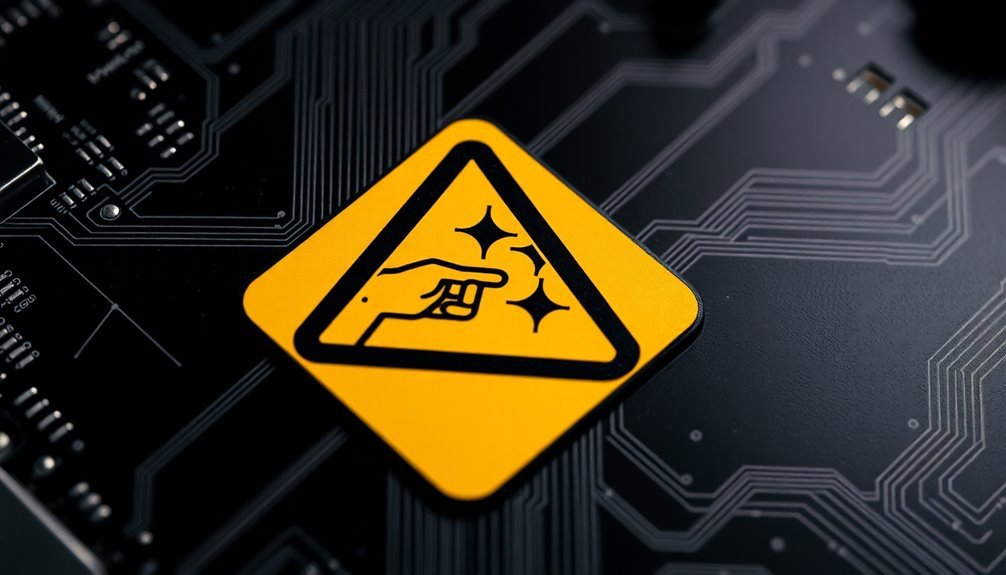Static-sensitive device warning symbols alert you to components that can be damaged by electrostatic discharge (ESD). You'll typically see a yellow hand inside a black triangle with a slash through it, indicating "don't touch" and warning of ESD sensitivity. If there's no slash and there's an arc instead, that means the item offers ESD protection. These symbols often include letters underneath to specify the type of protection (S for shielding, C for conductive, etc.) and may display sensitivity ratings. Ground point symbols, showing concentric circles, tell you where to connect ESD protection equipment. Understanding these symbols helps prevent costly damage to sensitive electronics.
Understanding ESD Warning Symbols

Warning symbols serve as critical visual indicators in the world of electrostatic discharge (ESD) protection.
When you encounter an ESD Susceptibility Symbol, you'll see a yellow hand with a slash through it inside a black triangle. This symbol warns you that a device or component is static-sensitive and requires proper handling precautions.
You shouldn't confuse this with the ESD Protective Symbol, which shows a hand with an arc but no slash, indicating items that offer ESD protection. The color choices for these symbols are intentional, with yellow or orange preferred on black backgrounds, and red is specifically avoided.
These symbols are used differently based on their purpose. The Susceptibility Symbol appears on individual components and assemblies to warn you about static sensitivity, while the Protective Symbol identifies items with ESD control properties like conductive materials, dissipative surfaces, or shielding capabilities.
When you see a letter beneath the Protective Symbol's triangle, it's telling you about the item's primary ESD control characteristic.
Types of ESD Safety Labels
The world of ESD safety labels consists of clear categories you'll need to understand for proper handling of static-sensitive devices.
You'll encounter standard ESD warning labels featuring the familiar black hand-in-triangle symbol on yellow backgrounds, along with specialized protective labels that identify ESD-safe equipment and grounding points.
When working with ESD-sensitive components, you must recognize both the standard susceptibility symbols and the protective symbols to maintain proper static control procedures. These labels play a vital role in alerting personnel to risks of potential equipment damage or destruction from electrostatic discharge.
Standard ESD Symbol Categories
Among the many aspects of ESD safety, standardized warning symbols play a crucial role in protecting sensitive electronic devices. You'll encounter four main categories of ESD symbols in electronic manufacturing and handling environments.
The ESD Susceptibility Symbol features a yellow hand in a black triangle with a slash, warning you about static-sensitive components that require careful handling. The ESD Protective Symbol, distinguished by an arc and no slash, indicates materials designed to provide ESD protection, such as specialized packaging or workplace equipment. Modern electronics with sub-micron microelectronic devices are particularly vulnerable to ESD damage, making these warning symbols increasingly important.
For grounding purposes, you'll see either the Earth Bonding Point Symbol or the newer ESD Common Ground Point Symbol, both showing where to connect your ESD control equipment. ESD Control Area Signs incorporate these symbols to mark zones where you must follow proper ESD procedures.
| Symbol Type | Key Features | Primary Use |
|---|---|---|
| Susceptibility | Yellow hand, slash | Warns of sensitive devices |
| Protective | Hand with arc | Indicates protective materials |
| Ground Point | Concentric circles | Shows connection points |
| Control Area | Combined symbols | Marks protected zones |
| Common Ground | No earth symbol | Identifies ground connections
Protective Label Color Coding
Color coding plays a vital role in ESD safety labeling, with yellow backgrounds and black symbols serving as the standard scheme for maximum visibility and recognition.
Yellow specifically warns of physical hazards and indicates caution, while the black symbols provide clear contrast for easy identification. Adherence to these ESD labeling standards remains voluntary in the United States, though following them promotes product consistency. It's important to note that red isn't used in ESD labels, as it's reserved for indicating danger or fire protection equipment.
When you're working with ESD safety labels, you'll encounter several distinct types. These include the Electrostatic Sensitive Device Label, Caution Contains Parts And Assemblies Label, Grounding Point Label, Notice To Avoid Equipment Damage Label, and ESD Protective Area Label. Each serves a specific purpose in protecting sensitive equipment.
While yellow and black is the preferred color combination, you can use monochromatic reproductions in any color that contrasts well with the background.
The OSHA color coding system also designates specific meanings to other colors: orange for dangerous machine parts, blue for restricted equipment use, and purple for radiation hazards.
When designing or selecting ESD labels, you'll want to make sure they comply with these color-coding standards while incorporating appropriate symbols from ANSI/ESD S8.1 and IEC standards.
ESD Symbol Color Meanings

Understanding ESD symbol colors helps prevent confusion and guarantees proper handling of static-sensitive devices.
You'll typically see two main types of ESD symbols, each with specific color guidelines. For the ESD susceptibility symbol, you'll find a yellow hand within a black triangle, usually set against a yellow or orange background.
The ESD protective symbol features a similar design but adds an arc to indicate protection. These symbols are commonly placed on signs in handling areas to warn personnel about required ESD protective measures.
It is essential to note that you shouldn't use red in either symbol, as red traditionally suggests a hazard to personnel. The standards ANSI/ESD S8.1 and IEC 61340-5-3:2015 explicitly prohibit red's use in these symbols.
While you can use different color combinations, they must provide adequate contrast with the background and remain easily visible.
When you're working with ESD symbols, you'll want to avoid common misinterpretations. Don't confuse the susceptibility symbol with the protective symbol, as this could lead to improper handling.
The preferred color scheme uses black and yellow elements, creating clear visibility while maintaining standardization.
Proper ESD Symbol Placement
You'll need to place ESD warning symbols at every visible access point where static-sensitive devices are handled or stored, ensuring they're immediately noticeable to anyone entering the area.
When applying symbols to different surface materials, you must follow specific guidelines for adhesion and durability, including using appropriate printing methods like silk screening for fabric or embossing for metal surfaces. These warning indicators often incorporate the ESD susceptibility symbol, consisting of a triangle with a reaching hand and slash, to clearly identify items that require special handling.
The symbols should be positioned at eye level (approximately 5 feet from the floor) whenever possible, making them easy to spot from typical working positions.
Visible Access Points Placement
Proper placement of ESD warning symbols at visible access points guarantees immediate recognition of static-sensitive areas and devices.
When you're working with ESD-susceptible components or assemblies, you'll need to certify that ESD Susceptibility Symbols are prominently displayed on both the items and their packaging. These symbols must be at least 12mm square unless space constraints make this impossible.
For items that provide ESD protection, you'll need to use the ESD Protective Symbol, which features an arc around the triangle without a slash through the hand. You'll find this symbol on ESD protective clothing, personnel grounding equipment, and specialized workstation materials. Regular assessments of symbol visibility and placement help maintain effective ESD control standards.
While you can use any color except red, yellow on black background is the preferred choice for maximum visibility.
When marking common point grounds, you'll need to use the ESD Common Point Ground Symbol, which consists of concentric circles with a thick outer ring. It's crucial to include text identification specifying the grounding point.
Remember that all symbols must be easily recognizable and comply with ANSI/ESD S8.1 standards to maintain effective ESD control procedures throughout your facility.
Surface Material Guidelines
When placing ESD warning symbols on surface materials, you'll need to match the symbol type with the material's static-dissipative properties. For proper identification, confirm your materials have surface resistivity between 1x10E5 and 1x10E11 Ω/square before applying any symbols. You'll want to use yellow-on-black color schemes, avoiding red due to its association with personnel hazards.
| Surface Type | Symbol Required | Placement Guidelines |
|---|---|---|
| Static-Dissipative | ESD Protective | Apply directly on material surface, visible during use |
| Grounding Points | Ground Point Symbol | Include text identification, place near connection point |
| ESD-Sensitive Areas | Susceptibility Symbol | Position at entry points and work surfaces |
When marking grounding points, you'll need to clearly identify common ground points and earth bonding locations where ESD control elements connect. For ESD-sensitive devices and assemblies, position the susceptibility symbol (yellow hand in black triangle) prominently on packaging and handling areas. Don't forget to apply ESD protective symbols on items designed to provide ESD protection, including specialized clothing and grounding equipment. Your symbols must remain visible during normal operation and handling procedures.
Location Height Requirements
Building upon surface material guidelines, specific height requirements guarantee maximum visibility of ESD warning symbols throughout protected areas.
You'll need to verify these symbols are placed at eye level whenever possible, particularly at entrances to ESD protected areas where personnel need immediate visual awareness.
When placing ESD symbols, you must maintain a minimum size of 12mm (1/2 inch) square to verify visibility, though you can go larger for better recognition.
You'll want to position warning signs and symbols at workstation entrances between 5-6 feet from the floor, where they're easily spotted during normal activities.
For device packaging and documentation, you should place symbols prominently on the outer surface where they won't be obscured by other labels or markings.
When marking grounding points, position the common point ground symbol directly adjacent to the connection point.
Don't use red coloring for any ESD symbols, as this could be mistaken for personnel hazard warnings.
Remember to take into account environmental factors when determining symbol placement height – they must remain visible and durable under typical workplace conditions while maintaining their intended warning function.
ESD Protection Level Indicators

ESD protection level indicators serve as essential classification markers that help identify and manage the electrostatic discharge sensitivity of electronic components and protective measures. You'll find standardized classification systems like ANSI/ESDA/JEDEC JS-001 that define Human Body Model (HBM) sensitivity levels, ranging from 0Z (<50V) to higher classifications.
| Protection Type | Indicator Purpose | Key Requirements |
|---|---|---|
| Device Classification | Identifies component sensitivity | Must use both HBM and CDM testing |
| Worksurface Protection | Shows surface discharge capability | Requires proper grounding connection |
| Packaging Standards | Indicates shielding level | Must meet ANSI/ESD S20.20 specs |
When you're working with ESD-sensitive components, you'll need to pay attention to multiple protection indicators. Worksurfaces must be properly marked to show their static dissipative or conductive properties, while packaging materials should display appropriate ESD symbols indicating their protection level. The ESD common ground point symbol helps you identify safe discharge points in your work area. These indicators work together to create a thorough ESD protection system, ensuring your sensitive electronic components remain safe from potentially damaging electrostatic discharges throughout handling, storage, and transport.
Key ESD Symbol Components
Standard ESD warning symbols consist of specific components that communicate critical information about static-sensitive devices and protective measures.
The most common ESD susceptibility symbol features a triangle with a reaching hand and slash, typically displayed in black on yellow, warning you not to touch sensitive components.
The ESD protective symbol differs by replacing the slash with an arc and adding specific letters to indicate protection types. You'll see "S" for shielding, "F" for field shielding, "C" for conductive, and "D" for dissipative properties. These symbols help you identify protective packaging materials and electrostatic protected areas (EPA).
When you're working with ESD equipment, you'll also encounter grounding symbols. The Common Ground Point and Earth Bonding Point symbols use concentric circles to show where you should connect ESD elements.
While both serve similar purposes, you can distinguish them by the presence of an earth ground symbol in the Earth Bonding Point version. These symbols often include text identification but shouldn't use red coloring to avoid suggesting personnel hazards.
Frequently Asked Questions
How Long Do ESD Protective Materials Maintain Their Effectiveness?
Most ESD protective materials last about 12 months, though some have a 3-year guarantee. You'll get longer life if you store them away from UV light. Dissipative tote boxes can maintain effectiveness continuously.
Can ESD Symbols Be Modified or Customized for Specific Company Requirements?
You can't arbitrarily modify standard ESD symbols, but you're allowed to add company-specific information alongside them. You must follow ANSI/ESD S8.1 guidelines while maintaining the standard symbol designs and approved colors.
What Happens if an ESD Symbol Is Accidentally Removed From Equipment?
If you accidentally remove an ESD symbol, you'll risk damaging sensitive components due to improper handling. Without the warning, personnel won't know to take necessary precautions, leading to potential device failure.
Are ESD Symbols Required by Law in All Manufacturing Facilities?
No, ESD symbols aren't legally required in all manufacturing facilities. While standards like ANSI/ESD S20.20 provide guidelines for ESD control, you'll need to follow your facility's specific requirements and customer contract obligations.
How Often Should ESD Protection Equipment Be Tested for Compliance?
You'll need to test your ESD protection equipment daily for wrist straps, quarterly for worksurfaces, and semi-annually for breakaway force tests. Specific frequencies should align with your facility's ESD control plan and risk level.
In Summary
You'll now have a better understanding of ESD warning symbols and their critical role in protecting sensitive electronic components. Remember to always check for these distinctive yellow and black labels, understand their protection levels, and follow proper handling procedures. Don't ignore these important visual warnings – they're your first line of defense against costly static damage to valuable electronic equipment.





Leave a Reply